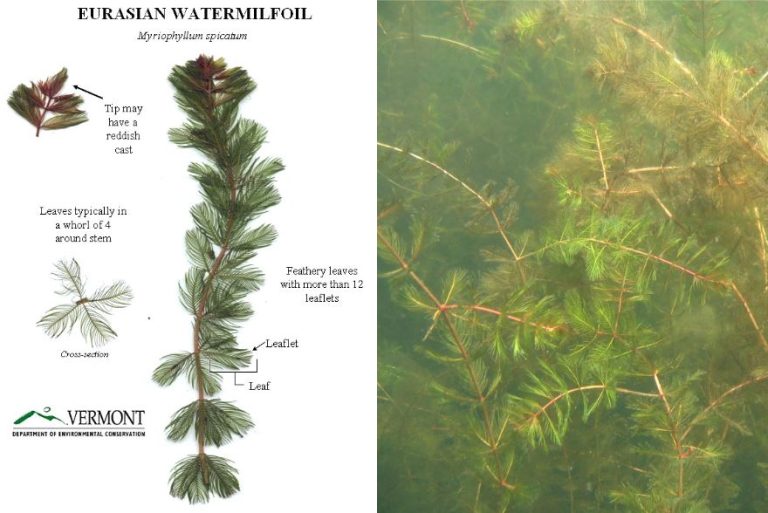We have heard from some homeowners that there may be Eurasian Watermilfoil in spots on Lake Shafer, currently. According to DNR and other sources, here is information on how to remove it if it’s in your area.

Milfoil – Common names: Eurasian watermilfoil, spiked watermilfoil, EWM. Milfoil is a submerged aquatic plant which grows in still or slow-moving water. It is native to Europe, Asia, and North Africa, but has a wide geographic and climatic distribution among some 57 countries, extending from northern Canada to South Africa. It has been found in 33 states in the US. It is considered to be a highly invasive species.
Eurasian Watermilfoil is nothing more than a weed, native to Europe and Asia. It’s interesting to note that Milfoil was used to decorate aquariums, but now, it’s mostly seen in lakes. Like weeds in our yards or gardens, it’s something that can harm other plants as well as put our lakes in danger. The long stems become easily tangled and form thick mats, making it hard for recreational lake users to enjoy the water by engaging in simple pleasures like boating, fishing, and swimming. The sleek stems can wrap around boat propellers, and too much Milfoil can hinder property values.
This dangerous plant also makes water life hard for other healthy and necessary aquatic plants by pushing them out of the way. It’s easy for Eurasian Watermilfoil to reproduce, and it only takes one strand of the weed to create more of the tangled stems. All it takes is one piece hanging on a fisherman’s boat to move the weed from place to place, creating even more of the weed and making weed takeover imminent. The plant grows quickly and is extremely hard to control, making eradication quite a chore, if not impossible altogether.
Milfoil also brings dangerous mosquitoes to bodies of water, and since it is harmful to good aquatic plants, any body of water where Milfoil grows may become less and less diverse as time goes on and the powerful plant damages all of the good lake life in its path.
Eurasian watermilfoil has slender stems up to 250 centimetres (8.2 ft) long. Submerged leaves (usually between 15–35 mm long) are borne in pinnate whorls of four, with numerous thread-like leaflets roughly 4–13 mm long. Plants are monoecious with flowers produced in the leaf axils (male above, female below) on a spike 5–15 cm long held vertically above the water surface, each flower is inconspicuous, orange-red, 4–6 mm long. Eurasian water milfoil has 12- 21 pairs of leaflets while northern watermilfoil M. sibiricum only has 5–9 pairs. The two can hybridize and the resulting hybrid plants can cause taxonomic confusion as leaf characters are intermediate and can overlap with parent species deceptively delicate and fragile in appearance, the Eurasian watermilfoil forms thick mats in shallow areas of a lake, quickly growing and spreading to block sunlight, killing off native aquatic plants that fish and other underwater species rely on for food and shelter.
Eurasian watermilfoil crowds out native plants and forms thick, floating mats on the surface of the water that can make boating, fishing and swimming difficult. with smooth stems that branch near the water surface.
Milfoil was likely first introduced to North America in the 1940swhere it has become an invasive species in some areas. By the mid 1970s, watermilfoil had also covered thousands of hectares in British Columbia and Ontario, Canada, and spread some 500 kilometres (310 mi) downstream via the Columbia River system into the Pacific Northwest of the United States. Eurasian watermilfoil is now found across most of Northern America where it is recognized as a noxious weed.
In lakes or other aquatic areas where native aquatic plants are not well established, the Eurasian plant can spread quickly. It has been known to crowd out native plants and create dense mats that interfere with recreational activity. Dense growth of Eurasian milfoil can also have a negative impact on fisheries by creating microhabitats for juvenile fish and obstructing space for larger fish ultimately disrupting normal feeding patterns. Due to the Eurasian milfoil plant’s inability to provide the same microhabitat for invertebrates as compared to native aquatic plant species, densely populated areas of Eurasian milfoil create an ecosystem with less food sources for the surrounding fish. Dense Eurasian milfoil growth can also create hypoxic zones by blocking out sun penetration to native aquatic vegetation preventing them from photosynthesizing. Eurasian watermilfoil grows primarily from broken off stems, known as shoot fragments, which increases the rate at which the plant can spread and grow. In some areas, the Eurasian Watermilfoil is an Aquatic Nuisance Species. Eurasian watermilfoil is known to hybridize with the native northern watermilfoil (M. sibiricum) and the hybrid taxon has also become invasive in North America. This hybridization has been observed across the upper midwestern United States (Indiana, Minnesota, Michigan, Wisconsin) and in the Northwest (Idaho, Washington).
Here are some ways of coping with the Eurasian Milfoil:
- Physical removal by professional divers.
- Grass eating carp.
- Weevils – a small herbivorous aquatic beetle.
- Harvesting or Dredging – be sure to remove all remnants of the milfoil.
- Aquatic Herbicides – Aquacide Pellets, a slow release tablet with 2,4-D.
The aquatic moth Acentria ephemerella, the water veneer moth, feeds upon and damages this water milfoil. It has been used as an agent of biological pest control against the plant in North America. The milfoil weevil (Euhrychiopsis lecontei) has also been used as biocontrol. Another method for biocontrol is Grass Carp, (one of the Asian Carp species) which have been bred as sterile, is sometimes released into affected areas, since these fish primarily feed on aquatic plants and have proven effective at controlling the spread. However, the carp prefer many native species to the milfoil and will usually decimate preferred species before eating the milfoil. In Washington State the success rate of Grass Carp has been less than expected. They were used in 98 lakes and 39 percent of them had no submerged plant life left after only a short time.
Since roughly 2000, hand-harvesting of invasive milfoils has shown much success as a management technique. Several organizations in the New England states have undertaken large scale, lake-wide hand-harvesting management programs with extremely successful results. Acknowledgment had to be made that it is impossible to completely eradicate the species once it is established. As a result, maintenance must be done once an infestation has been reduced to affordably controlled levels. Well trained divers with proper techniques have been able to effectively control and then maintain many lakes, especially in the Adirondack Park in Northern New York where chemicals, mechanical harvesters, and other disruptive and largely unsuccessful management techniques are banned. After only three years of hand harvesting in Saranac Lake the program was able to reduce the amount harvested from over 18 tons to just 800 pounds per year.
The only issue with chemical removal is that chemicals aren’t always approved depending on the state, and you may need to contact a professional to remove weeds using chemical methods. The DNR has a list of aquatic herbicides that are approved for DIY use. Treating large areas (more than one acre) in public lakes requires the approval of the DNR.
What You Can Do To Help Stop The Spread Of Milfoil
Here are the things YOU CAN DO to help stop the spread of milfoil, which are all applicable lake-wide. All require a bit of elbow grease on your part, but if we are all contributing, it can make a big difference around the lake.
- As a general rule, get as much milfoil out of the lake as possible. Let it dry out on land and dispose of it as you would yard waste.
- PLEASE don’t drive through milfoil patches with your boat which will create fragments. Fragments can easily seed new plants.
- If you do have milfoil on your prop, don’t just reverse and drive away, please remove it from the lake.
- If you have milfoil growing in your dock or swimming area, pull it out by the roots and remove it from the lake.
- If you see milfoil floating anywhere in the lake, near your dock, or along your shoreline, remove it from the lake.
- Obey boating regulations by travelling at no-wake, 5 MPH speeds within marked areas.



